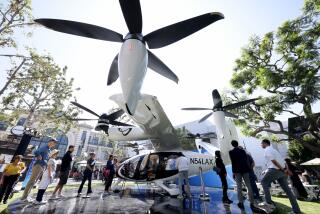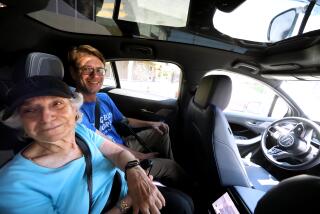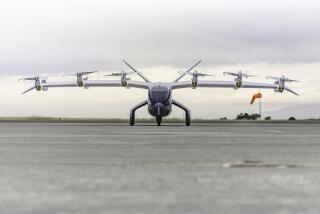Amateur cab driver says Nissan NV200 Taxi is in fare condition
If you want to find out how much Southern Californians love their cars, drive a taxi for a week.
I just checked out Nissan’s NV200 Taxi, a new van-like cab the automaker is marketing in New York, London and Los Angeles. Over seven days and 200 miles — from downtown L.A. to Laguna Beach and other beach cities — not one person hailed me.
I even drove 30 miles one afternoon with the “911” lights accidentally triggered. In New York, that signals the police that the cab driver faces some threat. No one noticed, including the two California Highway Patrol cars and one L.A. County sheriff’s deputy that passed me.
I had figured the funky design of Nissan’s taxi — and its giant New York taxi sign and fake medallion — would have at least drawn some attention, maybe a question or two.
But my only “fares” were friends and family. My only earnings were a single soft serve ice cream cone. Sure, people take taxis here, to go to the airport or get home from the bar. But they order them up by phone or mobile app. If you waited on a Los Angeles street corner to hail a cab, you’d be waiting a good while.
To develop the NV200, Nissan started with the frame of its small cargo van. It then worked with New York City transportation officials and cab companies to optimize it for taxi use. This is no recycled Toyota Prius or old Ford sedan.
Much of the design was done at Nissan’s studio in La Jolla. Testers then drove it on “New York Avenue,” really a pockmarked stretch of track at its Arizona testing facility, intended to replicate harsh city streets.
That approach helped Nissan win a competition by the New York City Taxi and Limousine Commission to become the exclusive taxi provider for the city. The 10-year contract was expected to generate sales of at least 14,000 taxis and could generate as much as $500 million in revenue for Nissan.
The automaker beat out Ford and Karsan, a Turkish manufacturer. But the commission has put the regulation on hold for now, pending a legal challenge from taxicab companies, which argued that the commission lacked the authority to require them to purchase specific vehicles.
In June, a state appeals court ruled that the commission’s plan was legal, but New York officials have yet to implement the regulation. Nissan says the decision affirms its exclusivity in the non-hybrid taxi market in New York.
The $30,600 taxi is starting to go into service in New York and other cab-centric cities, such as London. Nissan said it also is marketing the cab in L.A. and Seattle. But the automaker acknowledges that it faces stiff competition out West from sellers of used cabs, and it really needs a natural gas or hybrid model to make headway in the L.A. market.
Not surprisingly, the Nissan drives like a taxi. It rumbles along. It is noisy. The steering is utilitarian and occasionally ponderous. The power might be adequate for driving the dense neighborhoods of New York or London, but it needs more zip for wide-open SoCal.
The cab runs on a 131-horsepower, four-cylinder engine mated to a continuously variable transmission to increase fuel economy. The Environmental Protection Agency rates the taxi at 24 miles per gallon in combined city and highway driving; I achieved about 23 mpg.
It is comfortable to drive and has a great seat for someone who will spend hours shuttling people around. But the cab also is a giant moving blind spot. This is needless. Nissan makes blind-spot warning systems available in many vehicles. Such warnings use lights and sounds to warn a driver that it’s not safe to make a lane change.
With taxis constantly cutting in and out of traffic, why not use the technology here? It would improve safety for the driver and other cars.
My pretend fares found the passenger cabin roomy and comfortable for up to three people. They liked the 15-inch video display and thought the credit card reader in the back would be a great way to pay. The passenger screen on the prototype I tested was not fully functional, but Nissan says it will display local news segments, a map of where the cab is going, fare information, the weather and some advertising.
Passengers also admired the large transparent roof in the cabin. It’s only marginally useful driving around suburban Southern California, but one can imagine viewing the Eiffel Tower, New York’s rows of skyscrapers and the London Eye through the clear panoramic roof. It would be amazing at night.
The sliding doors, with entry steps and grab handles, made entering and exiting the cab easy. The rear air conditioning allows the passengers to set the climate to their own comfort level.
My non-paying passengers also noticed the detail work Nissan put into the vehicle. The black upholstery simulates the look and feel of leather and has contrasting yellow stitching that ads just a hint of pizazz. Seat belt buckles are bright yellow and easy to spot. Thankfully, the front-wheel-drive vehicle lacks the rear hump that disrupts the passenger floor area in other cabs.
There’s one feature my passengers thankfully didn’t have the chance to appreciate — rollover curtain air bags for all occupants. Nissan also notes that the NV200 taxi is the first New York taxi to be crash-tested with taxi equipment installed, including the partitions and other structures.
A large, bullet-resistant, clear polycarbonate divider separates the passengers from the driver, but an intercom makes communication easy. Note to passengers: Even with the intercom off, I could hear you complaining about my driving.
My passengers did grumble about a lack of comfortable armrests and a cramped seat up front, where a fourth fare could ride. The partition doesn’t allow the front passenger seat to slide back. The luggage compartment is also a bit tight for a family’s worth of stuff, especially if the members are not efficient packers.
As Nissan taxi guru Peter Bedrosian explains, designing and building a taxi is more than slapping a coat of yellow paint on the vehicle and putting a light on the roof.
The upholstery, for example, must be extra durable, especially in the back seat, which gets a lot more use than in a normal car. Ditto for rear doors, which get opened and closed thousands more times, and so need heavy-duty construction.
Nissan offers a 150,000-mile powertrain warranty for the taxi — that compares to 60,000 miles for a regular Nissan — and a 36,000-mile bumper-to-bumper warranty, the same for its regular line.
Along with an engine built with hardened components for the heavier duty, Bedrosian says the average Nissan taxi used in New York will put on about 350,000 miles. Many of those cabs will find their way into taxi services elsewhere as used vehicles. Nissan used a 700,000-mile testing target during the car’s design and development, he said.
Winning the New York cab competition has given Nissan the type of visibility that it expects will translate into sales elsewhere. The automaker already has heard from cab companies in Argentina and Japan, Bedrosian said.
“Some of the operators in Japan wanted the taxi complete with New York city graphics,” he said. “We couldn’t do that.”
Twitter: @latimesjerry







